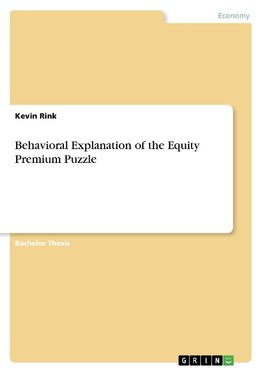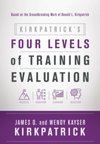
-
 Anglický jazyk
Anglický jazyk
Behavioral Explanation of the Equity Premium Puzzle
Autor: Kevin Rink
Bachelor Thesis from the year 2010 in the subject Business economics - Business Management, Corporate Governance, grade: 1,0, European Business School - International University Schloß Reichartshausen Oestrich-Winkel, language: English, abstract: Ever since... Viac o knihe
Na objednávku, dodanie 2-4 týždne
38.90 €
bežná cena: 44.20 €
O knihe
Bachelor Thesis from the year 2010 in the subject Business economics - Business Management, Corporate Governance, grade: 1,0, European Business School - International University Schloß Reichartshausen Oestrich-Winkel, language: English, abstract: Ever since the equity premium puzzle (EEP) was published by Mehra and Prescott (1985), it has become one of the most investigated problems in economics (Mehra, 2003, p. 54). The EEP describes the fact that we cannot link historic stock returns with the volatility of consumption growth (in a sense to be made precise below). Mehra and Prescott call this a puzzle as their consumption-based asset pricing model can not plausibly explain the S&P 500's annual risk premium of 6.2% over relatively risk-free governmental treasury bills between 1889 and 1978. This model reproduces an equity premium of 6.2% solely by adapting unreasonable estimates of agents' risk aversion (Mehra & Prescott, 1985, pp. 155-156). In this way, the model also predicts an extreme size of the risk-free rate (Cochrane, 2000, p. 416). Thus, the equity premium is not able to be explained exclusively by the risk of stock price fluctuations.
(...) This thesis will examine the EPP from a behavioral perspective. The major research question to be pursued is this: How do behavioral approaches explain the equity premium puzzle? In order to answer this question, a variety of subtasks must be addressed. This includes the investigation of the initial model of Mehra and Prescott (1985) as well as its underlying assumptions. That is, in particular, needed because several well-established classical assumptions must be dropped to set up descriptive behavioral models. In addition, implications from psychology and behavioral economics must be introduced to answer the overall question of this thesis. Hence, the thesis will focus on the notions of loss aversion, narrow framing, and regret theory in an effort to explain
- Vydavateľstvo: GRIN Verlag
- Rok vydania: 2010
- Formát: Paperback
- Rozmer: 210 x 148 mm
- Jazyk: Anglický jazyk
- ISBN: 9783640607754











